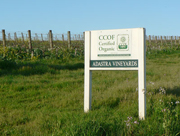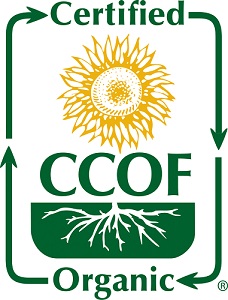"Ingredients ... Organic Grapes"Although only three words long, the statement on Adastra’s label is testament to a years-long commitment to meet the highest standards for organic farming practices.Since 2005, Adastra’s vineyards have been certified by the California Certified Organic Farmers (CCOF), which has among the strictest standards in the nation for organic agriculture. Grapegrowers must farm their grapes organically according to CCOF standards for three years prior to certification. In addition to completing a comprehensive application form (a stack of paper about 1.5” thick), the grower is required to maintain an ongoing log of farm activities, which is reviewed annually by independent inspectors. We believe that organically farmed grapes taste better, and therefore make better wine. But besides quality products, there are tangible benefits from organic farming, including a healthier soil and healthier environment, making Adastra a more pleasant place to work and live. We are also certified by Fish Friendly Farming and Napa Green. Buy Adastra today to taste the difference organic grapes make. Organic FAQWhat is organic agriculture?Organic food is produced without using most conventional pesticides; fertilizers made with synthetic ingredients or sewage sludge; bioengineering; or ionizing radiation. Organic meat, poultry, eggs, and dairy products come from animals that are given no antibiotics or growth hormones. (Definition courtesy of the National Organic Program.) Is organic the same as sustainable? No. Only growers such as Adastra who subject themselves to certification by independent agencies earn the right to use the term “organic.” While there are some “sustainable” certification programs at county and appellation levels, they are less strict containing the use of farming inputs, for example. Doesn’t organic farming raise your prices? We have found organic viticulture to be a little more expensive than conventional farming, but not prohibitively so, especially given that growing premium wine grapes on a small scale is already a costly business. Does this mean the wine is organic? The grapes are organically grown, but the wine is made conventionally. We use sulfites because we want the wine to age well in the bottle and reliably preserve its delicious taste.  CCOF sign at Adastra Vineyards
|
 CCOF logo
 Lush cover crop grows in Adastra's organic vineyard in springtime.
ORGANIC ALPHABET SOUP USDA and NOP In 2002, the United States Department of Agriculture (USDA) established the National Organic Program (NOP). The NOP develops, implements, and administers national production, handling, and labeling standards for organic agricultural products. It also accredits the certifying agents who inspect organic production and handling operations to certify that they meet USDA standards. One of these certifying agents is the California Certified Organic Farmers (CCOF). CCOF CCOF was founded in 1973 as a mutual help and certifying organization for organic farmers. Over the years, CCOF has been involved in numerous initiatives on behalf of organic growers, including the Organic Farmers Research Foundation (OFRF) in 1990, and the Organic Materials Review Institute (OMRI). OMRI Principal among OMRI’s functions is to maintain the OMRI list, detailing information about what materials are allowed and prohibited for use in organic production. This list is not exclusive; it only contains materials submitted by manufacturers to OMRI for certification. However, it is comprehensive and provides a useful reference for growers: if a material is “OMRI-listed” then the grower knows that it can safely be used without jeopardizing organic status. CDFA & COP California Department of Food and Agriculture is responsible for enforcement of the Federal Organic Foods Production Act of 1990 and the California Organic Products act of 2003. Growers selling more than $5,000 of organic produce annually must be certified by the CDFA. The California Organic Program is funded entirely by industry fees. |
